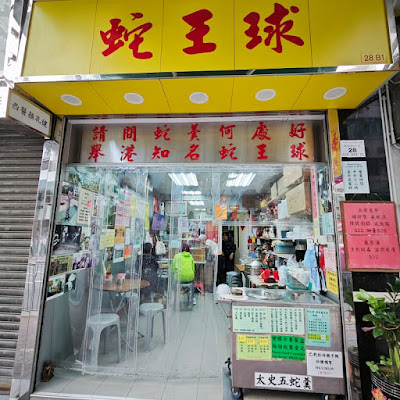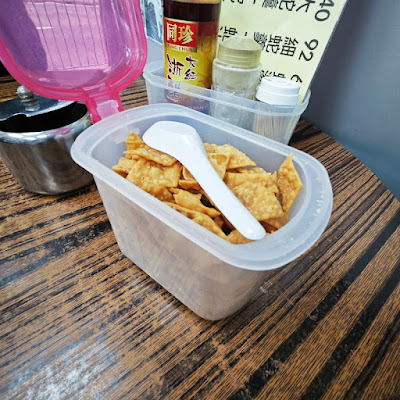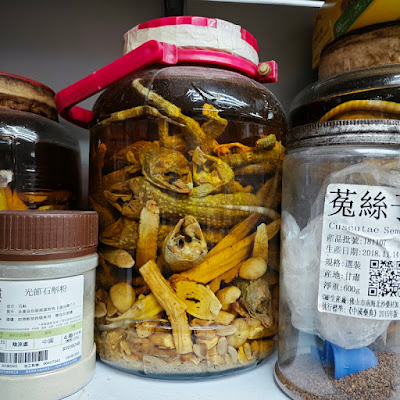04-024
Snake soup
After talking
about the exotic special menu of our local Pizza Hut, I am going to show you
what authentic snake soup looks like. Normal Chinese restaurants do not serve
snake soup or snake meat very often. Snakes are mainly served in specialty
restaurants dedicated to serving snake soup.
Snake soup used
to be more popular in the old days. It has become less popular now, especially
among the young people. Due to the decline of the popularity, finding a snake
restaurant in the city is not always an easy task.
On the new
year’s day of 2024, I had a chance to visit one of the snake restaurants. The
shop’s name is Snake King Kau, located in Kennedy Town, one of the old
districts of Hong Kong.
The restaurant
is very small in size. It does not even have a proper restaurant license. A
food producer license is all they have. This means they cannot put more than 8
seats inside the restaurant. They mainly serve takeaway, though dine-in is also
welcome.
The choice of
food is limited. They sell mainly snake soup and snake broth. In addition, they
also sell glutinous rice with Chinese sausages, chicken rice with snake sauce,
and, if you are a meat lover, deep-fried snake nuggets. For those who do not
like eating snake, they offer preserved duck leg with rice, mutton with rice,
boiled vegetable, and Chinese herbal tea. Last, but not the least, they also
sell Chinese herbal tea. I will explain what herbal tea is later.
Let us have a
look at their prices. From left to right, the combo menu shows:
- Large size snake soup & Glutinous rice with Chinese sausages - $130
- Small size snake soup & Glutinous rice with Chinese sausages - $82
- Snake broth & Glutinous rice with Chinese sausages - $58
- Large size snake soup & Chicken rice with snake sauce - $140
- Small size snake soup & Chicken rice with snake sauce - $92
- Snake broth & Chicken rice with snake sauce - $68
- Deep fried snake nuggets - $80
On the à la carte menu, from left to right, it shows:
- Large size snake soup - $100
- Small size snake soup - $52
- Snake broth - $28
- Tortoise soup - $52
- Chicken rice with snake sauce - $50
- Preserved duck leg with rice - $50
- Glutinous rice with Chinese sausage - $33
- Boiled vegetable - $25
On the last row
at the bottom of the menu, it says $12 for an extra piece of Chinese sausage or
Chinese black pudding.
In addition, there are some special menus on the wall.
One of them is the Chinese herbal tea
menu. The herb for making the tea is called taxillus chinensis. Taxillus
chinensis, also known as mulberry mistletoe or Sang Ji Sheng 桑寄生 in Chinese, is
a parasitic plant that grows on the branches of trees, especially mulberry
trees. It has been used for medicinal purposes for hundreds of years in
traditional Chinese medicine. The main function of taxillus chinensis is to
nourish the liver and kidney, strengthen the bones and muscles, expel wind and
dampness, and prevent miscarriage. It also has various pharmacological effects
such as anti-inflammatory, antioxidant, anticancer, and antihypertensive.
It costs $22
for a bowl of taxillus chinensis herbal tea and $26 if you want to add an egg
to it.
What could be
more exotic than snake meat? How about turtle! We use softshell turtle, mixed
with Chinese medicine, to make a soup. It costs $600 for one pot, enough for a
whole family.
Another menu item,
less exotic but still unusual, is tortoise jelly and tortoise soup. Both sell
for $52 each. There is no tortoise meat in the jelly or the soup. We only use
the shell of the tortoise. No, they are not vegetarian.
You don’t have
to worry about eating snake meat by mistake when you are in the city. Snake
meat is very expensive. In fact, some unscrupulous snake restaurants may
replace snake meat with chicken or pork in your soup. But at Snake King Kau, you
were given a choice. If you don’t trust them, you can buy a whole frozen snake
and take it home to cook it yourself. They sell them for $250 per snake.
Let me show you
what a bowl of snake soup looks like. On the table of a snake restaurant, there
are normally some condiments. You will find pepper, Chinese vinegar, lemongrass
(inside the tin box) and fried dough (inside the plastic box). Depending on
your preference, some people like to mix them into the snake soup. I only like
adding lemongrass to the soup, not the others.
This is what
snake soup looks like. I ordered a small bowl. The size is not too large, only
around 400ml. It is a thick soup with shredded snake meat, chicken, pork, fish
maw, black fungus, and other ingredients. Like the snake soup pizza, not all
the meat inside the bowl is snake. Snake meat has a very special texture and
can be easily distinguished. The meat is rather tasteless though.
As a
traditional snake restaurant, there is more to explore inside Snake King Kau.
Apart from those special menus, you can also find photos and newspaper
clippings hung on the wall. They show the brave history of the restaurant
owner. You can see how many big snakes were hunted down by Mr. Kau in the past.
On the shelf of
Snake King Kau, there are bottles of wine, made with snakes or other animals,
such as deer tails, lizards or mice. Chinese believe that these exotic
ingredients have magical power, especially for men. The wine is limited
production and is stored inside recycled Blue Girl beer bottles. (Yes, Mr. Kau
likes Blue Girl.) Some of them do not even have labels. Their prices are also
expensive. A bottle of snake wine costs $160 to $180, depending on their
function. A bottle of deer tail wine costs $300.
The most
expensive ones are these two bottles, the mice wine and the snake penis wine,
each costing $800, which is more than USD 100 per bottle.
I think that is
enough for today.
Go back to the Lobby ...





















No comments:
Post a Comment